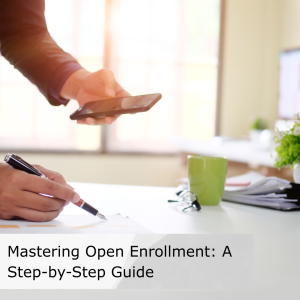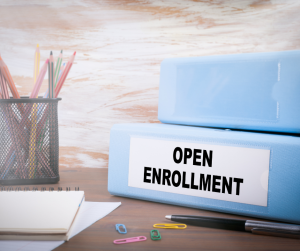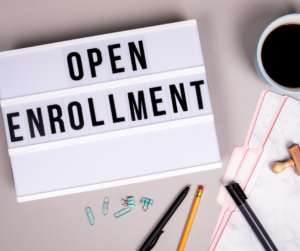
by admin | Oct 21, 2025 | Employee Benefits, Open Enrollment
 Open enrollment is a hectic and critical period for employers that often brings a risk of compliance errors. These mistakes can confuse employees and cause missed benefits, while also exposing employers to legal risks.
Open enrollment is a hectic and critical period for employers that often brings a risk of compliance errors. These mistakes can confuse employees and cause missed benefits, while also exposing employers to legal risks.
This article highlights five common compliance pitfalls to avoid during open enrollment:
- Ineffective Communication of Benefit Changes – Benefit offerings often change annually due to plan design updates or regulatory mandates. Employers must clearly notify employees of any changes, including cost-sharing adjustments and new benefits, well before open enrollment. Using multiple communication channels and simple explanations helps employees make informed choices. Updates should also be reflected in required plan documents like the Summary Plan Description (SPD) or Summary of Material Modifications (SMM).
- Overlooking Election Deadlines
– Open enrollment periods should end well before the new plan year to allow orderly processing and compliance with tax laws. Employees’ benefit elections under Section 125 cafeteria plans are typically irrevocable for the plan year unless a qualifying life event occurs. Clear communication and encouraging early enrollment help prevent late or mistaken elections, which are difficult to correct.
- Failing to Distribute Required Health Plan Notices
– Employers must provide various health plan notices during open enrollment, such as the Summary of Benefits and Coverage (SBC), COBRA notices, CHIP notices, WHCRA notices, Medicare Part D disclosures, and HIPAA privacy notices. These notices ensure employees are informed of their rights and plan details and must be delivered in timely fashion. Electronic delivery is often permitted with proper safeguards.
- Not Providing Materials to All Eligible Individuals – It’s crucial to distribute open enrollment information not only to active employees but also to eligible individuals on leave, furlough, or COBRA continuation. A multi-channel approach with diligent tracking of distribution reduces the risk of missed communications and potential disputes.
- Neglecting Disclosure of Reasonable Alternatives in Wellness Programs – Wellness programs that impose surcharges or provide rewards based on health standards must offer reasonable alternative ways to meet requirements, per HIPAA rules. Employers need to disclose these alternative standards and provide contact information and assurance that personal physician recommendations will be accommodated. Compliance reduces legal risks related to premium surcharges and discrimination claims.
By proactively addressing these areas, employers can help employees confidently choose benefits while reducing compliance risks and administrative challenges.

by admin | Sep 30, 2025 | Custom Content, Employee Benefits
 Open enrollment doesn’t have to be a stressful administrative task. When planned well in advance, it becomes a valuable opportunity to review and enhance your benefits offerings, demonstrating your commitment to your team’s physical, mental, and financial well-being. A well-executed open enrollment can boost employee morale, improve retention, and ensure your workforce is supported.
Open enrollment doesn’t have to be a stressful administrative task. When planned well in advance, it becomes a valuable opportunity to review and enhance your benefits offerings, demonstrating your commitment to your team’s physical, mental, and financial well-being. A well-executed open enrollment can boost employee morale, improve retention, and ensure your workforce is supported.
Use this checklist to guide your organization through a successful open enrollment period, from the initial planning stages to the final follow-up.
Phase 1: Plan and Prepare Early (8-12 Weeks Before)
- Leverage technology: Consider a benefits portal where employees can easily access health plan documents such as benefit summaries, plan flyers, and contributions charts.
- Gather Employee Feedback: Solicit and record employee questions, concerns, and suggestions from the previous year. Consider conducting a survey to understand what benefits or improvements your workforce desires for the upcoming year.
- Evaluate and Enhance Offerings: Identify new or updated enrollment options.
- Develop Core Resources: Begin preparing your benefits guide and consider implementing or updating online enrollment tools and software.
- Create Educational Content: Produce digital educational materials like FAQs and videos.
Phase 2: Communication Kick-Off (4 Weeks Before)
- Launch Communication Campaign: Start sharing enrollment information across all selected online platforms (e.g., intranet, company newsletter, email).
- Equip Management: Develop a resource kit for your management team, including talking points and FAQs, to ensure they can confidently discuss open enrollment with their teams.
- Integrate Reminders: Add open enrollment reminders and key dates to the email signatures of your management team.
Phase 3: The Final Countdown (1-2 Weeks Before)
- Host Informational Sessions: Schedule and host virtual benefits meetings, webinars, and one-on-one sessions as needed to answer specific questions.
- Distribute Physical Materials: Provide informational pamphlets and mailers to employees.
- Prepare for Questions: Have answers ready for FAQs to ensure a smooth process.
Phase 4: During Open Enrollment
- Ensure Full Distribution: Make sure every employee receives the following information:
- The open enrollment timeline and deadlines
- A statement of their current coverage
- Information on plan-specific changes and rates
- Summaries of available plans
- The open enrollment booklet and any necessary forms
- Contact details for all plan carriers
- Promote Discussion: Remind managers to actively discuss benefit options with their teams.
- Provide Support: Offer ample time for enrollment and send frequent reminders throughout the period.
- Last-Minute Reminder: Schedule a company-wide reminder for the day before the enrollment deadline to prevent employees from missing the window.
Phase 5: Post-Enrollment Actions (1-2 Weeks After)
- Audit and Submit: Review all enrollment forms for missing or incorrect information.
- Ensure Compliance: Confirm that all relevant health care reform requirements have been met.
- Follow Up: Collect feedback from employees on their open enrollment experience.
Bonus Tip for Success
Consider holding a separate, off-cycle enrollment period to highlight voluntary benefits that might be overlooked during the busy primary open enrollment. This provides employees with a dedicated opportunity to explore additional benefits, potentially increasing your overall benefits utilization and employee satisfaction.
We are here to help; reach out to us with any open enrollment questions or needs you may have!

by admin | Sep 4, 2024 | Employee Benefits, Hot Topics, Open Enrollment
 Navigating health insurance can feel like planning a vacation. You wouldn’t pack for a beach trip if you’re headed to the mountains, right? Similarly, choosing a health plan requires careful consideration.
Navigating health insurance can feel like planning a vacation. You wouldn’t pack for a beach trip if you’re headed to the mountains, right? Similarly, choosing a health plan requires careful consideration.
Open enrollment is your chance to design a plan tailored to you; it is your yearly opportunity to review and adjust your employee benefits package.
What is Open Enrollment?
Open enrollment is a specific window of time, typically every autumn, when employees can enroll in, change, or drop benefits offered by their employer. These benefits typically include health insurance, dental, vision, life insurance, and medical spending accounts. Outside of this period, changes are usually only allowed under special circumstances. Open enrollment is like a health checkup for your financial well-being, ensuring you have the right coverage to protect yourself and your family.
Why is Open Enrollment Important?
- Life Changes: Major life events like marriage, birth, or adoption can significantly impact your benefit needs.
- Plan Changes: Insurance providers often adjust their plans and rates annually.
- Cost Control: Reviewing your options can help you find ways to save money on premiums and out-of-pocket costs.
- Maximizing Benefits: Ensure you’re taking full advantage of the benefits offered by your employer. You may even discover hidden gems in your plan like discounts or a wellness program within your current plan.
Tips for Open Enrollment Success:
- Understand Open Enrollment Terms
- Review Your Current Coverage: Understand your existing benefits and how you’ve used them throughout the year.
- Estimate Healthcare Costs: Consider factors like doctor visits, prescriptions, and potential major medical expenses.
- Compare Plan Options: Evaluate different plans based on premiums, deductibles, copays, and network size.
- Involve Your Family: Discuss your options with your family to ensure everyone’s needs are met.
- Ask Questions: If you have questions, don’t hesitate to contact your HR department or benefits provider.
- Remember the 4 D’s When Choosing a Plan: Take into account doctors, drugs, diagnostics and deductibles. Be sure your doctors are in-network, your drugs are covered, and key diagnostic tests like blood tests and imaging are accessible and your deductible meets your financial needs.
Open enrollment season is right around the corner! Take the time to prepare now; remember, the decisions you make during open enrollment can have a significant financial impact on you for the following year. So, be sure to read up, think of your options, and select carefully!

by admin | Sep 27, 2023 | Employee Benefits
 For millions of Americans, the end of the year is open enrollment season – a yearly opportunity to take stock of your health care needs and select the health insurance plan that works best for you. It is a window of time – typically in the fall – when you can sign up for health insurance, review, assess, and modify your existing benefits.
For millions of Americans, the end of the year is open enrollment season – a yearly opportunity to take stock of your health care needs and select the health insurance plan that works best for you. It is a window of time – typically in the fall – when you can sign up for health insurance, review, assess, and modify your existing benefits.
There are more choices than ever to help you find a plan that will best suit your health needs. Think of it like planning a trip: you don’t pack a surfboard if you are planning to hike in the mountains. Likewise, there is a lot to think about when selecting a health plan for the next year. What does it cost? Does it include your prescription or preferred doctors? Understanding health insurance basics and how open enrollment works is essential for making informed choices about your benefits and insurance coverage.
Here’s How Open Enrollment Typically Works:
- Eligibility: Anyone eligible for health insurance can participate in Open Enrollment. This includes you, your dependents, and individuals looking to buy insurance through the individual marketplace (e.g., through the ACA exchanges)
- Review Options: During the Open Enrollment period, you have the opportunity to review your current insurance coverage and assess their healthcare needs for the upcoming year. You should consider factors like changes in your health, anticipated medical expenses, and any new coverage options that might be available.
- Enrollment or Changes: You can use the Open Enrollment period to either enroll in a new insurance plan, make changes to your existing plan, or renew your current coverage. This might involve switching plans, adding or removing dependents, changing coverage levels, or adjusting other plan details.
- Deadline: Open Enrollment is time sensitive. Once the designated period ends, you generally cannot make changes to your insurance coverage until the next Open Enrollment period unless you experience a qualifying life event (such as marriage, birth of a child, job loss, or relocation), which triggers a Special Enrollment Period.
- Coverage Start: The new coverage usually begins at the start of the upcoming calendar year, though this can vary depending on the specific insurance plan and enrollment date.
Which Plans Don’t Use Open Enrollment?
- CHIP (Children’s Health Insurance Program) – CHIP offers low-cost health coverage for children from birth through age 18. CHIP permits enrollment at any time so you can ensure your children have coverage year-round.
- Medicaid – Medicaid is a joint federal and state program that helps cover medical costs for some people with limited income and resources. Medicaid allows enrollment in health insurance during any time of year, provided you qualify.
- Short-Term Health Insurance – health insurance plan with a limited duration, typically several months to a year. These plans are geared toward people who need temporary medical insurance to bridge the gap between longer-term plans. These plans don’t have enrollment periods because the need for this type of insurance is difficult to predict.
It’s important to note that missing the Open Enrollment period without a qualifying life event can result in being without health insurance coverage until the next Open Enrollment period. To ensure you have the coverage you need, carefully review your options and make any necessary changes during the designated Open Enrollment timeframe.
Health insurance providers are committed to helping all Americans make informed health coverage choices for themselves and their families. Open Enrollment is a great time to explore the benefits already available to you in your current plan, including discounts and wellness opportunities that can save you money and keep you healthy.

by admin | Oct 11, 2022 | Employee Benefits, Open Enrollment
 Choosing the right benefits during open-enrollment season is so important and can help save money. It can also give individuals and families broader support with their health. Benefits like medical coverage are particularly important with high inflation having such a big impact on people’s budgets.
Choosing the right benefits during open-enrollment season is so important and can help save money. It can also give individuals and families broader support with their health. Benefits like medical coverage are particularly important with high inflation having such a big impact on people’s budgets.
A survey by UnitedHealthcare found that nearly 40% of employees devote less than one hour to the open enrollment process. It is crucial to carefully analyze your benefits during open enrollment as any decisions you make will likely be locked for the year until the next open enrollment period. Don’t rush into open enrollment without carefully considering your options!
Here are some tips to ensure you make the most of your open enrollment:
Be Prepared
Open enrollment typically lasts for a short period (2-4 weeks) so knowing what you need to do ahead of time can be a big stress reliever. A good starting point is to consider how your needs have changed since last year. For example, maybe you got married or received a raise. These changes may require a change in coverage, whether it be for life, health or disability insurance, and it is important to consider how these or any other expected life changes will impact your insurance needs.
Review Any Changes Made by Your Employer
It is common for employers make changes to plans and premiums to keep up with the times. When you receive your open enrollment packet to review plan options, it is important to consider all aspects of coverage and the total cost of coverage. The total cost is impacted by the deductibles, premiums, co-insurance and maximum out-of-pocket expenses.
Take note of whether your employer made any changes in providers. If this happens, your current physician or dentist may be out-of-network which will result in out-of-network costs or denied claims.
Review Your Insurance Options
The largest portion of employer benefits is health insurance so it is important to choose the plan that is best for you and your family. Important questions to ask are: how often do you have medical expenses? Are lower premiums or lower out-of-pocket costs more important to you? Do you take expensive prescription drugs? Can you afford hefty out-of-pocket costs if there is an emergency?
There are 3 main plan types:
- Preferred Provider Organization (PPO)
PPO’s are a popular choice since they allow you to see any doctor or specialist and don’t require a referral from your primary care physician (PCP) to see a specialist. However, PPO premiums are usually much more than other plans. To help reduce costs, remember that using in-network providers and specialists who are part of your PPO network will save you money.
- Health Maintenance Organization (HMO)
HMOs have lower premiums than PPOs but they require you to stay in-network. You will also need a referral from your PCP to see a specialist. The idea is that the PCP coordinates your care.
- High Deductible Health Plan (HDHP)
Another low-cost option is a high-deductible health plan. What sets HDHPs apart from other plans is their low premiums and high deductibles. That means you won’t have to pay as much each month for premiums but you will need to pay more of the healthcare costs when you need services. To help you pay for the bigger deductible, employers usually pair an HDHP with a health savings account (HSA), which allows you to save for medical expenses, including deductibles and copays.
Learn How FSAs, HRAs, and HSAs Differ
Many employers offer accounts that help you save for medical expenses:
- Flexible Spending Account (FSA)
You decide how much pre-tax money to put into the employer owned account through payroll deductions and then you can use that money to pay for out-of-pocket medical expenses. You lose that money if you change jobs or don’t use it by the end of the year.
- Health Savings Account (HSA)
Connected to a HDHP, an HSA lets you set aside money on a pre-tax basis to pay for qualified medical expenses. The account is yours, so you keep it if you change jobs. The money rolls over each year so you don’t have to worry about “using it or losing it.”
- Health Reimbursement Arrangement (HRA)
An HRA is similar to an HSA except that the employer owns the account so you can’t take it with you when you change jobs. You’re able to contribute money for medical expenses just like an HSA or FSA. Money can also be carried over to the next year like an HSA.
Open enrollment is an important time of year and is worth investing some time and energy to decide what is best for you and your family. Health insurance is one of the most important purchases you make. By doing your homework and taking the time to carefully consider your options, you’ll find the plan that is right for you!

 Open enrollment is a hectic and critical period for employers that often brings a risk of compliance errors. These mistakes can confuse employees and cause missed benefits, while also exposing employers to legal risks.
Open enrollment is a hectic and critical period for employers that often brings a risk of compliance errors. These mistakes can confuse employees and cause missed benefits, while also exposing employers to legal risks.



